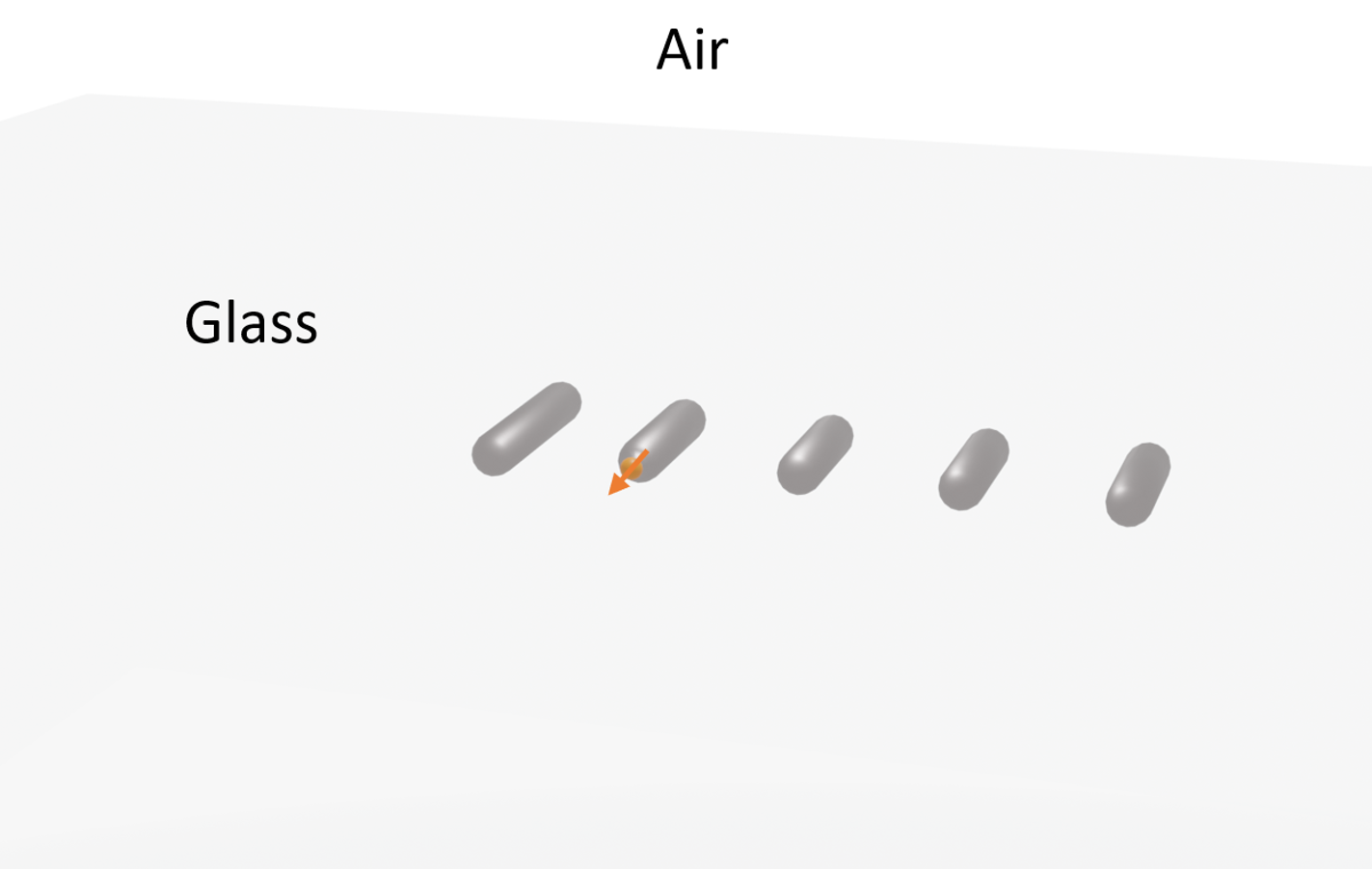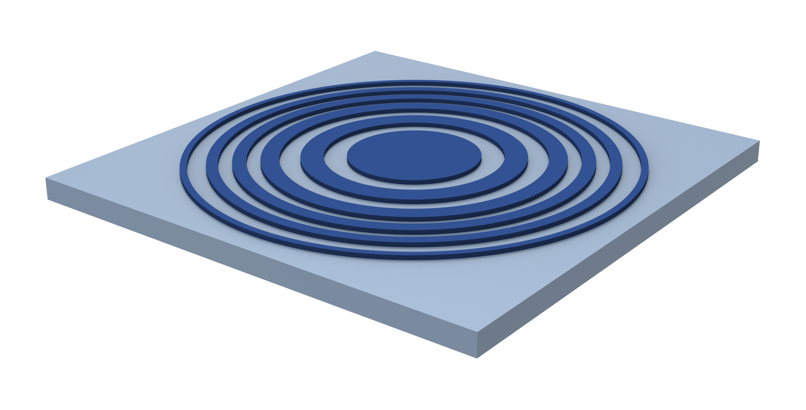This notebook reproduces the phase behavior of cross-polarized scattering from gold V-shaped antennas on a silicon substrate, as demonstrated in the following paper:
Yu, N., Genevet, P., Kats, M. A., Aieta, F., Tetienne, J.-P., Capasso, F., & Gaburro, Z. (n.d.). Light Propagation with Phase Discontinuities: Generalized Laws of Reflection and Refraction. DOI: 10.1126/science.1210713.
The goal is to demonstrate the general workflow for simulating the antennas and extracting phase information from the complex monitor data. We will use two approaches:
-
Using a FieldMonitor with Perfectly Matched Layers (PML) to calculate the phase directly from the field values. This is an explicit approach to determine the phase of a single antenna but may require a large simulation domain. In this setup, the source is a Total-Field Scattered-Field (TFSF) source, which excites a plane wave inside its domain and only allows scattered fields to propagate outside it, allowing the phase of the scattered fields to be analyzed independently of the excitation.
-
Using a DiffractionMonitor with Periodic boundary conditions to extract the phase from the complex zero-order diffraction amplitude. With this method, we can assume a local periodic approximation and calculate the phase using a much smaller simulation domain. For this setup, we can use a regular PlaneWave source.
As we will see, the results from both methods match well.
A more complete example simulating the full metasurface presented in the paper can be found here.
For additional examples, check our Example Library.
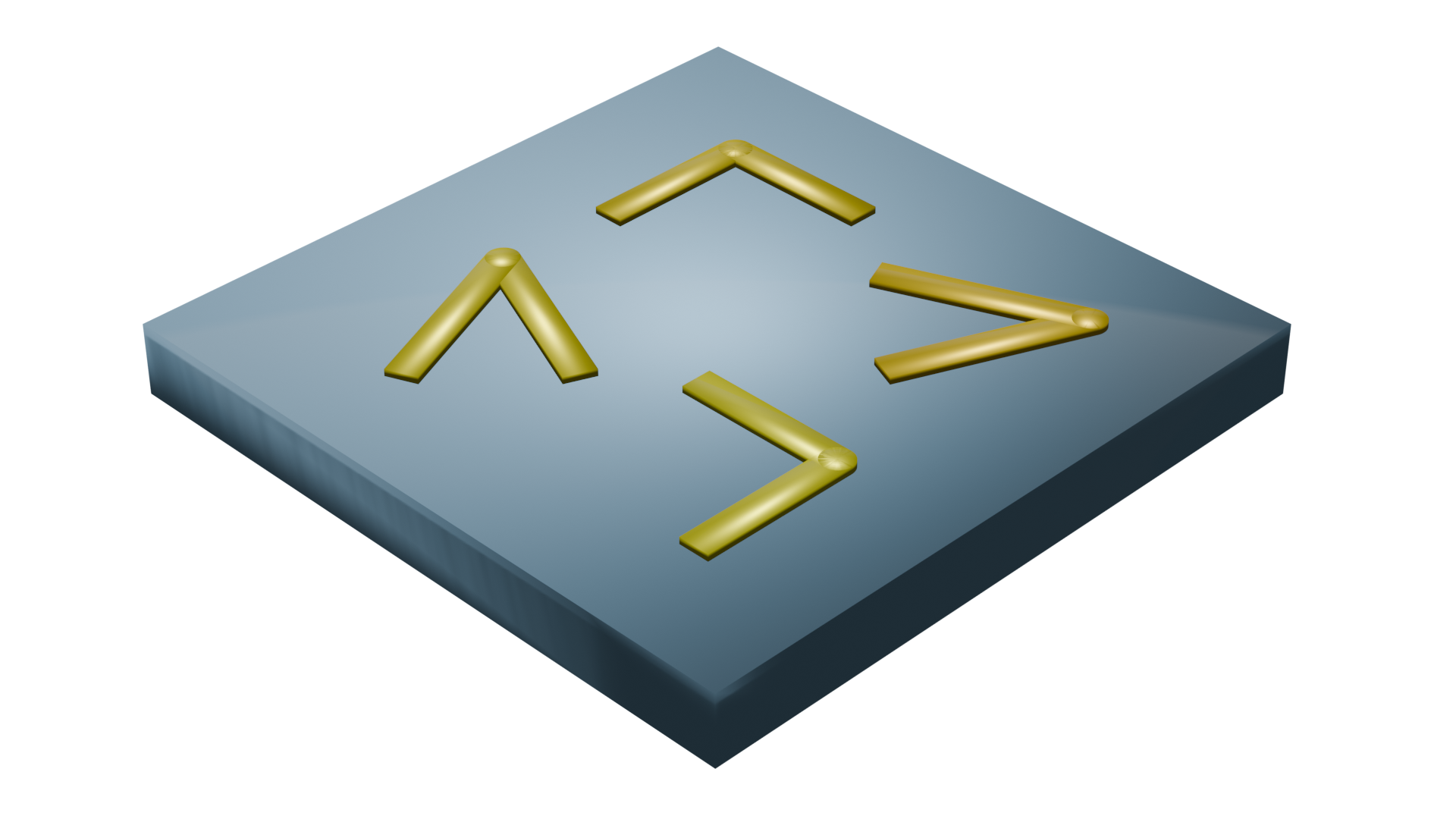
Simulation Setup¶
First, we define the global parameters used to create the structures.
These constants specify the wavelength, geometry, and time-domain settings shared across all antenna configurations.
# Importing necessary libraries for simulation and visualization
import matplotlib.pyplot as plt
import numpy as np
import tidy3d as td
from tidy3d import web
# Define simulation parameters
wl = 8 # Target wavelength
cylinder_radius = 0.1 # Radii of the cylindrical antennas
fcen = td.C_0 / wl # Central frequency
fwidth = 0.2 * fcen # Frequency width
run_time = 2e-12 # Simulation run time
substrate_thickness = 10 # Thickness of the Si substrate
air_size = 40 # Air region to visualize the scattered fields
sx = 2 * wl # Dimensions in the xy plane
sy = 2 * wl
sz = substrate_thickness + air_size # Total length of the simulation
structure_z_position = -sz / 2 + substrate_thickness + cylinder_radius # Position of the antennas
size_z_source = 2 # Size of the TFSF source
size_source = (2.5, 2.5, size_z_source)
center_source = (
0,
0,
structure_z_position - cylinder_radius + size_z_source / 2,
) # Center position of the TFSF source
14:54:37 -03 ERROR: Failed to apply Tidy3D plotting style on import. Error: 'tidy3d.style' not found in the style library and input is not a valid URL or path; see `style.available` for list of available styles
Parametric V-Antenna Geometry¶
The helper v_antenna converts intuitive geometric inputs (arm length, opening angle, rotation) into Tidy3D primitives. Each simulation clones this geometry with different parameters to sample the phase response.
# Define the V-antenna structure
width = 0.22 # Width of the antenna arms
thickness = 0.05 # Thickness of the antenna arms
def v_antenna(center, radius, length, delta, theta):
# Define the material properties
medium = td.material_library["Au"]["Olmon2012crystal"]
delta1 = (-theta + delta / 2) * np.pi / 180
delta2 = (-theta - delta / 2) * np.pi / 180
# Calculate offsets to centralize the antenna
dx_to_centralize = (length / 2) * np.cos(np.deg2rad(theta))
dy_to_centralize = (length / 2) * np.sin(np.deg2rad(theta))
# Define the sphere at the center of the antenna
sphere1 = td.Structure(
geometry=td.Cylinder(radius=width / 2, center=center, axis=2, length=thickness).translated(
-dx_to_centralize, dy_to_centralize, 0
),
medium=medium,
)
# Define the first arm of the antenna
dx = (length / 2) * np.cos(delta1) - dx_to_centralize
dy = (length / 2) * np.sin(delta1) + dy_to_centralize
c1 = (
td.Box(size=(length, width, thickness), center=(0, 0, 0))
.rotated(delta1, 2)
.translated(*center)
.translated(dx, dy, 0)
)
s1 = td.Structure(geometry=c1, medium=medium)
# Define the second arm of the antenna
dx = (length / 2) * np.cos(delta2) - dx_to_centralize
dy = (length / 2) * np.sin(delta2) + dy_to_centralize
c2 = (
td.Box(center=(0, 0, 0), size=(length, width, thickness))
.rotated(delta2, 2)
.translated(*center)
.translated(dx, dy, 0)
)
s2 = td.Structure(geometry=c2, medium=medium)
return [s1, s2, sphere1] # Return the antenna components
# Dictionary containing the length and angle parameters of the 8 antennas
dic_numerator = {
0: (180, 45, 0.75),
1: (45, -45, 1.35),
2: (-90, -45, 1.12),
3: (-90 - 45, -45, 0.95),
4: (180, -45, 0.75),
5: (45, 45, 1.35),
6: (90, 45, 1.12),
7: (90 + 45, 45, 0.95),
}
Mesh Override and Source Placement¶
Since the structures are much smaller than the target wavelength, it is convenient to create a mesh override region around the metasurface to properly resolve the structures, while using a coarser mesh in the free-space propagation region.
Because the TFSF source performs best in a uniform mesh, the size and position of the override region are set equal to those of the source.
# Define the mesh override region
mesh_override = td.MeshOverrideStructure(
geometry=td.Box(center=center_source, size=size_source), dl=(0.02, 0.02, 0.02)
)
# Redefine positions for the new geometry
structure_z_position = -sz / 2 + substrate_thickness + thickness / 2
size_z_source = 2
size_source = (2.5, 2.5, size_z_source)
center_source = (0, 0, structure_z_position - thickness / 2 + size_z_source / 2)
# Define the TFSF source
source_time = td.GaussianPulse(freq0=fcen, fwidth=fwidth)
source = td.TFSF(
center=center_source,
size=size_source,
direction="+",
injection_axis=2,
pol_angle=0,
source_time=source_time,
)
# Adding monitors to keep track of the field profile at the target frequency
field_mon_y = td.FieldMonitor(
center=(0, 0, 0), size=(td.inf, 0, td.inf), freqs=[fcen], name="field_mon_y"
)
field_mon_x = td.FieldMonitor(
center=(0, 0, 0), size=(0, td.inf, td.inf), freqs=[fcen], name="field_mon_x"
)
Simulation using FieldMonitor and PML¶
Now, we can create the simulation object, defining the boundaries as PMLs.
A silicon substrate and absorbing boundaries define the background structure. We reuse this template with different antenna geometries to form the full batch submission.
# Defining the structure modeling the substrate
substrate = td.Structure(
geometry=td.Box(center=(0, 0, -sz / 2), size=(2 * sx, 2 * sy, 2 * substrate_thickness)),
medium=td.Medium(permittivity=3.47**2),
)
# Defining the base simulation
sim = td.Simulation(
size=(sx, sy, sz),
grid_spec=td.GridSpec.auto(override_structures=[mesh_override]),
structures=[],
sources=[source],
monitors=[field_mon_y, field_mon_x],
run_time=run_time,
boundary_spec=td.BoundarySpec(x=td.Boundary.pml(), y=td.Boundary.pml(), z=td.Boundary.pml()),
)
Next, we create a dictionary containing one simulation for each antenna.
simulations = {}
fig, axes = plt.subplots(2, 4, figsize=(12, 10), constrained_layout=True)
for key, ax in zip(range(8), axes.flatten()):
delta, theta, length = dic_numerator[key]
antenna = v_antenna(
center=(0, 0, structure_z_position),
radius=cylinder_radius,
length=length,
delta=delta,
theta=theta,
)
name = f"ScatteringCylinder_{key}"
simulations[name] = sim.updated_copy(structures=antenna + [substrate])
# Plot the simulation with monitor_alpha=0 and source_alpha=0
simulations[name].plot(z=structure_z_position, ax=ax, monitor_alpha=0, source_alpha=0)
# Calculate the phase applied by the antenna (example calculation)
applied_phase = key * (np.pi / 4) # Assuming phase steps of π/4
applied_phase_deg = np.degrees(applied_phase) # Convert to degrees
# Set the title with the phase
ax.set_title(f"Phase: {applied_phase_deg:.1f}°", fontsize=24)
# Remove axis labels and ticks
ax.axis("off")
ax.set_xlim(-1, 1)
ax.set_ylim(-1, 1)
# Show the figure
plt.show()
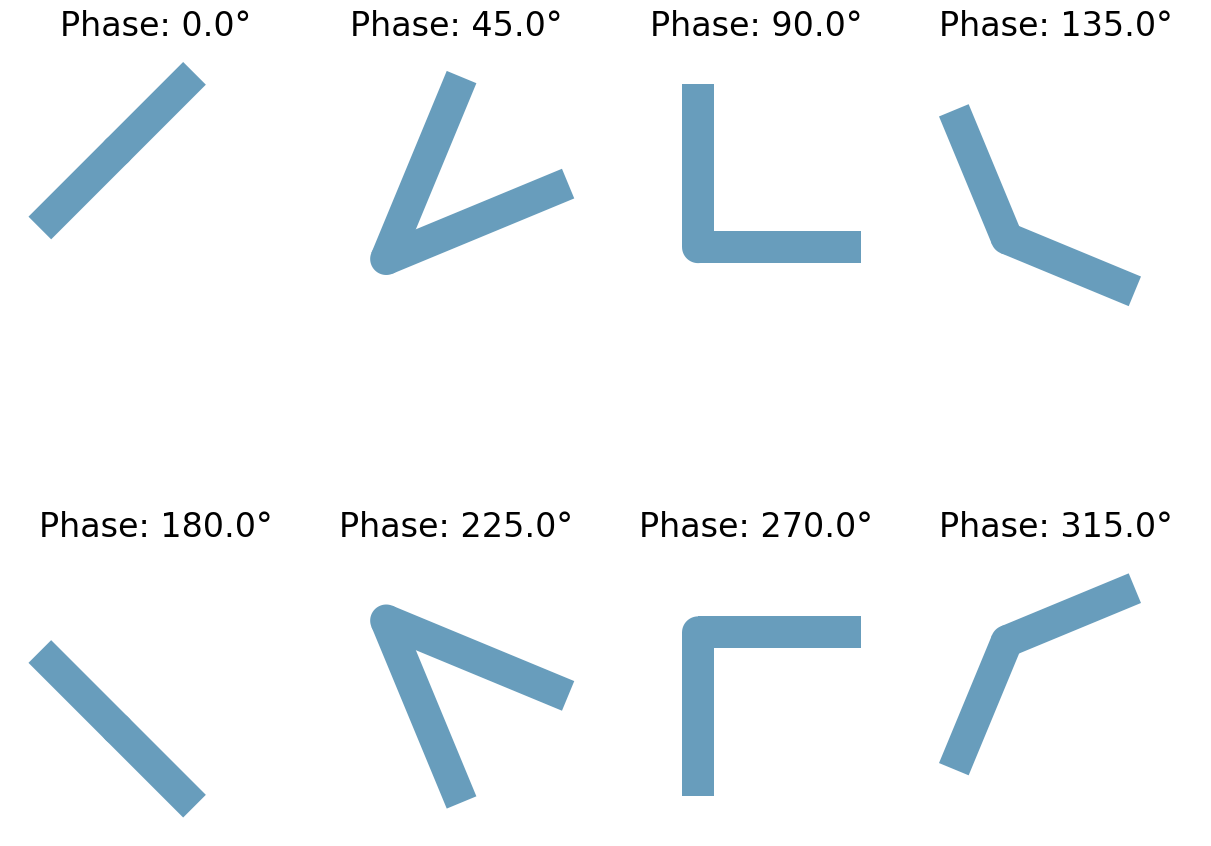
Before running the simulation, we can visualize the setup to ensure everything is correctly placed.
simulations["ScatteringCylinder_0"].plot_3d()
# Creating the batch object
batch = web.Batch(simulations=simulations, verbose=True)
# Running the batch
results = batch.run(path_dir="dataScatteringCylinders")
Output()
14:54:43 -03 Started working on Batch containing 8 tasks.
14:54:51 -03 Maximum FlexCredit cost: 1.575 for the whole batch.
Use 'Batch.real_cost()' to get the billed FlexCredit cost after the Batch has completed.
Output()
14:54:57 -03 Batch complete.
Output()
# Plotting the scattered fields and phases
N = len(simulations)
fig, axes = plt.subplots(2, int(N / 2), figsize=(5 * int(N / 2), 12), constrained_layout=True)
keys = list(simulations.keys())
for col, i in enumerate(range(0, N, 2)):
key = keys[i]
result = results[key]
field = result["field_mon_y"].Ey.squeeze()
x = result["field_mon_y"].Ey.x.squeeze()
z = result["field_mon_y"].Ey.z.squeeze()
amplitude = field.real.T
phase = np.angle(field).T
axes[0, col].pcolormesh(x, z, amplitude, vmin=-0.5, vmax=0.5, cmap="RdBu_r")
axes[0, col].set_title(f"Antenna {key}Re(Ey)", fontsize=14)
axes[0, col].axis("off")
axes[1, col].pcolormesh(x, z, phase, vmin=-np.pi, vmax=np.pi, cmap="twilight")
axes[1, col].set_title("Phase (rad)", fontsize=12)
axes[1, col].axis("off")
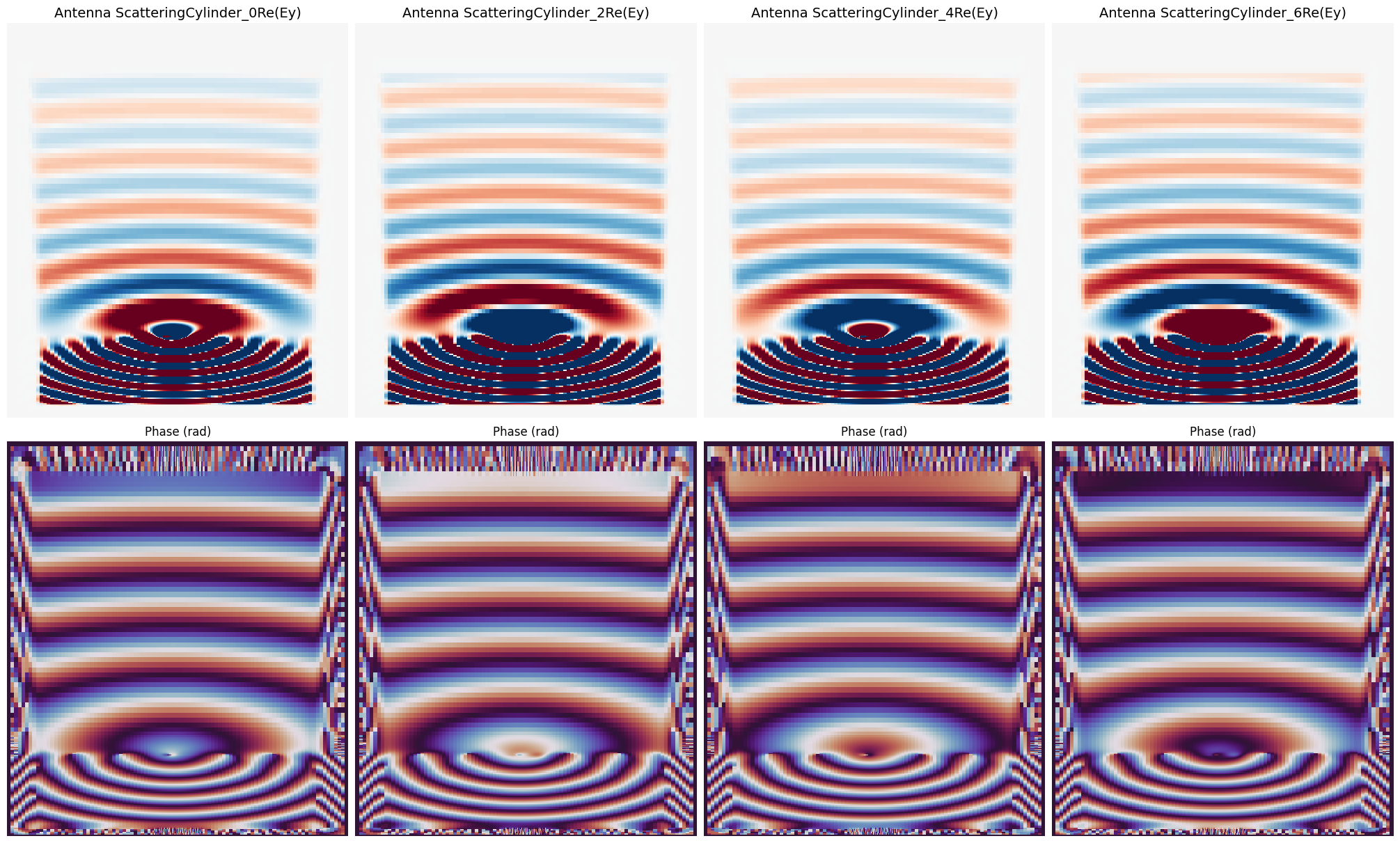
As we can see, the phase of the transmitted fields increases across different antennas.
Extracting On-Axis Phase Delays¶
We probe the center of the field_mon_y plane, compute the complex phase, and reference everything to antenna 0.
It can be observed that the antennas provide a continuous phase variation over 360 degrees.
# Collect phase at monitor intersection for each antenna
phases = []
for name in simulations:
monitor = results[name]["field_mon_y"]
value = monitor.Ey.sel(z=20, method="nearest").squeeze()
phases.append(np.angle(np.mean(value.data)))
phases = np.array(phases)
# Reference all phases to antenna 0
phase_deg = -np.degrees(np.unwrap(phases - phases[0]))
# Bar chart summarizing relative phase at z = 0
fig, ax = plt.subplots(figsize=(6, 4))
indices = np.arange(len(phase_deg))
ax.bar(indices, phase_deg)
ax.set_xticks(indices)
ax.set_xticklabels(list(simulations.keys()), rotation=45, ha="right")
ax.set_ylabel("Phase shift (deg) relative to antenna 0")
ax.set_title("Cross-polarized phase at x = 0, z = 0")
ax.axhline(0, color="k", linewidth=0.8)
ax.grid(True, axis="y", alpha=0.3)
fig.tight_layout()
# Tabulate numeric values for quick inspection
print("Phase shift summary (deg):")
for name, value in zip(simulations.keys(), phase_deg):
print(f" {name}: {value:.2f}")
Phase shift summary (deg): ScatteringCylinder_0: -0.00 ScatteringCylinder_1: 38.03 ScatteringCylinder_2: 107.05 ScatteringCylinder_3: 162.07 ScatteringCylinder_4: 180.00 ScatteringCylinder_5: 218.03 ScatteringCylinder_6: 287.05 ScatteringCylinder_7: 342.07

Phase calculation using a DiffractionMonitor and periodic boundary conditions¶
Now, we can adapt the simulations from the previous section to use periodic boundaries and replace the FieldMonitor with a [DiffractionMonitor]. We will also replace the TFSF source with a PlaneWave source.
With this approach, we can also reduce the simulation size in the z-direction.
# Define boundary conditions: periodic in x and y, PML absorbing boundaries in z
boundary_spec = td.BoundarySpec(
x=td.Boundary.periodic(), y=td.Boundary.periodic(), z=td.Boundary.pml()
)
# Set simulation domain center and size for periodic setup
sim_periodic_center = (0, 0, structure_z_position)
sim_periodic_size = (sx, sy, 2 * wl)
# Create a diffraction monitor above the structure to capture transmitted/reflected fields
diffraction_monitor = td.DiffractionMonitor(
center=(0, 0, structure_z_position + wl - 1),
size=(td.inf, td.inf, 0),
freqs=[fcen],
name="diffraction_monitor",
)
# Define a plane wave source below the structure
pw_source = td.PlaneWave(
center=(0, 0, structure_z_position - wl + 1),
size=(td.inf, td.inf, 0),
source_time=td.GaussianPulse(freq0=fcen, fwidth=fwidth),
name="pw_source",
direction="+",
)
# Creating the simulation dictionary for the Batch
sims_periodic = {
i: simulations[i].updated_copy(
boundary_spec=boundary_spec,
monitors=[diffraction_monitor],
sources=[pw_source],
size=sim_periodic_size,
center=sim_periodic_center,
)
for i in simulations.keys()
}
# Visualizing the setup
sims_periodic["ScatteringCylinder_0"].plot_3d()
# Running the Batch
batch_periodic = web.Batch(simulations=sims_periodic, verbose=True)
results_periodic = batch_periodic.run(path_dir="dataScatteringCylindersPeriodic")
Output()
14:55:55 -03 Started working on Batch containing 8 tasks.
14:56:03 -03 Maximum FlexCredit cost: 0.969 for the whole batch.
Use 'Batch.real_cost()' to get the billed FlexCredit cost after the Batch has completed.
Output()
14:56:36 -03 Batch complete.
Output()
Now, we can analyze the amplitude of the first diffraction order of the cross-polarized component and again use np.angle to extract the phase.
As we can see, the results match very well with those from the previous setup.
phase_s = []
phase_p = []
for k in results_periodic.keys():
sim_data_periodic = results_periodic[k]
diffraction_data = sim_data_periodic["diffraction_monitor"]
phase_s.append(np.angle(diffraction_data.amps.sel(orders_x=0, orders_y=0, polarization="s"))[0])
phase_s = np.array(phase_s)
# Reference all phases to antenna 0
phase_deg_periodic = -np.degrees(np.unwrap(phase_s - phase_s[0]))
# Bar chart summarizing relative phase at z = 0
fig_periodic, ax_periodic = plt.subplots(figsize=(6, 4))
indices_periodic = np.arange(len(phase_deg_periodic))
ax_periodic.bar(indices_periodic, phase_deg_periodic)
ax_periodic.set_xticks(indices_periodic)
ax_periodic.set_xticklabels(list(sims_periodic.keys()), rotation=45, ha="right")
ax_periodic.set_ylabel("Phase shift (deg) relative to antenna 0")
ax_periodic.set_title("Cross-polarized phase at x = 0, z = 0 (periodic)")
ax_periodic.axhline(0, color="k", linewidth=0.8)
ax_periodic.grid(True, axis="y", alpha=0.3)
fig_periodic.tight_layout()
# Tabulate numeric values for quick inspection
print("Phase shift summary (deg) - periodic:")
for name, value in zip(sims_periodic.keys(), phase_deg_periodic):
print(f" {name}: {value:.2f}")
Phase shift summary (deg) - periodic: ScatteringCylinder_0: -0.00 ScatteringCylinder_1: 37.99 ScatteringCylinder_2: 107.35 ScatteringCylinder_3: 162.19 ScatteringCylinder_4: 180.00 ScatteringCylinder_5: 217.99 ScatteringCylinder_6: 287.35 ScatteringCylinder_7: 342.19















